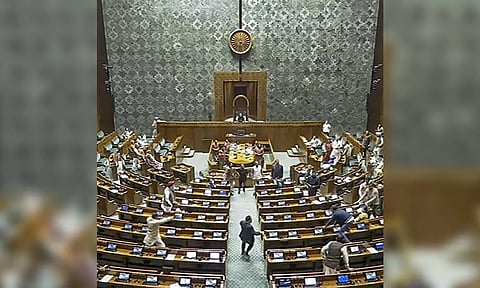

NEW DELHI: In the context of the protest by a band of young men and women inside and outside Parliament last week, Rahul Gandhi is right to swing our focus to unemployment.
While the breach of security arrangements in and around Parliament has received much of our lawmakers’ attention, the plight of jobless youth, which the protesters intended to bring to the nation’s notice, must be addressed just as much as the failure of our security agencies.
The broad contours of India’s unemployment problem are well-known, even if the Modi government has fought shy of facing up to the latest data, produced by its own agencies. However, the profile of the six protesters brings to the fore one particular aspect of the problem, the failure of our higher education system to serve our youth and the economy, that cries out for policy attention beyond cosmetic measures and lip service.
The protesters came from disparate backgrounds but are united by the theme of youngsters from mofussil India trying to claw their way out of underprivileged statuses to join the organised workforce.
One is an engineering graduate who couldn’t find a job and returned to his father’s farm in rural Karnataka. The lone woman in the group accumulated four college degrees but found them inadequate to get a teacher’s job.
Another protester, the son of daily-wagers, is a Class 12 dropout, but well-read enough to be inspired by Bhagat Singh, who did not make the cut in army recruitment rallies.
These are sons and daughters of farmers, traders, and craftsmen, whom we lure to higher education with the promise of livelihoods more secure than those eked out by their parents.
India produces 2.5 million graduates and diploma holders every year as a result of this migration by our youth away from rural, marginal to industrial urban livelihoods. However, a large number of them find only betrayal at the other end of the bridge.
The State of Working India 2023 report by Azim Premji University says 42.5 percent of graduates under 25 remain unemployed.
The government’s latest Periodic Labour Force Survey (PLFS) reports, while claiming that unemployment is trending lower, that only 40.1 per cent of people in the age group 15-29 had any work between July 2022 and June 2023.
The PLFS data shows a huge bulge in unemployment at higher educational levels:
The unemployment rate for those educated up to primary school is only 0.5 percent, rising to 12.2 per cent for diploma holders, 13.4 percent for graduates, and 12.1 per cent for post-graduates and above.
Within streams of higher education, courses slanted to urban, socially-advantaged students do better in terms of employability than those that are the recourse of kids from less privileged backgrounds.
The India Skills Report for 2023 reports, for example, that 57.4 per cent of B Tech grads passed the employability test but only 34.2 per cent of ITI graduates and 27 per cent of polytechnic pass-outs.
Our policy response to this mismatch between the educational supply chain and the demands of the economy has been to add random skilling programs as an adjunct to the formal education system rather than to make them an intrinsic part of the graduate curriculum.
Higher, technical educational coursework needs an overhaul to make it more useful to students and industry alike: legitimise and promote technical education in the mother tongue, make courses vocational, mandate the industry to offer paid internships to students, and crack down on corruption in regulatory agencies.